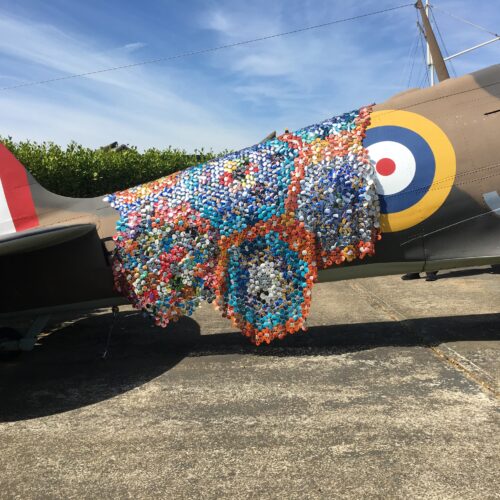
Whitworth textiles exhibitions review
Textiles exhibitions are not that common in our national museums and galleries, especially textile design exhibitions, so it’s exciting that the Whitworth Art Gallery in Manchester is currently host three textiles and surface pattern exhibitions concurrently.
The Tibor Reich exhibition in particular is worth the visit. On until August 2016, the exhibition is a retrospective of Reich Ltd’s brightly coloured post-war industrial design. The second exhibition room is a riot of colour, with overlapping fabrics hung from the ceiling and so many patterns and colours vying for your attention. The range of the output is fascinating, not just in terms of the different styles employed but also in their application. The designs were applied to fabrics, both printed and woven, blankets, tufted and woven rugs, as well ceramics, including interior tiles, pots and tea sets.

The fabrics are heavily pattern-based, encompassing a vast range of design styles, from detailed florals to bold geometrics, explored at varying scales across the fabrics. Some of the ceramics on display also employ pattern repeats but many of them use a markedly different aesthetic, featuring his figurative illustrations of characterful people. The first exhibition room displays lots of these illustrative drawings alongside paper-based designs and architectural designs for his own house.
 Madison Blankets, 1957. Dobby woven cotton bouclé.
Madison Blankets, 1957. Dobby woven cotton bouclé.
I love seeing a designer’s process as well as the outcome, so I found the styled desk space and vintage video reel discussing Reich’s design process particularly satisfying. The desk displayed various tools, tests and a sketchbook, along with swatchbooks and prints. The tests were squares of photographs, some scattered, others arranged in compositions. The video explaining how he used this fairly new photographic technology to capture patterns in brickwork or tree branches, for example. Through framing and cropping these photos he’d extract motifs and patterns, which he’d repeat and tessellate to create one style of pattern.

Reich’s love of nature and folk art, as well as the influence of his Hungarian heritage and Modernism are clear in the varied output of Tibor Ltd. If you’re interested in colour, pattern and design it’s worth the trip to see Tibor Reich’s interdisciplinary approach and varied design output.
In the room adjoining the Reich exhibition is a Wallpaper exhibition, on until 4th September 2016, which shows highlights from the Whitworth’s collection of 1950s and 1960s wallpapers. The styles varied from linear, graphic patterns, florals, bold geometrics, conversation pieces and many more, with varying scales of pattern and types of repeat, with a range of printing processes used to produce the papers. It was hard to ignore the influence of mid-century style on current design as some of the patterns felt so familiar and contemporary. A simple, linear Modernist design by Lucienne Day was a highlight for me, as were the display cases in the centre of the space which presented the swatchbooks from which customers would choose their designs.
 Roger Nicholson, Lightblown Aspinall (WPM) Aerial, c.1961, Screen-printed; Lucienne Day, Prisma, c.1955. Machine Printed Wallpaper.
Roger Nicholson, Lightblown Aspinall (WPM) Aerial, c.1961, Screen-printed; Lucienne Day, Prisma, c.1955. Machine Printed Wallpaper.
Revolutionary Textiles 1910-1939 is a third textiles exhibition, which is on display on the ground floor until January 2017. This exhibition charts the changes in textiles during the second two decades of the 20th century and the influences that produce those changes, including technological developments and material advances, more women entering art schools and the first world war and ongoing social unrest. The fabrics and garments on display use a fascinating range of materials and processes. Whilst I was visually most drawn to the fabulously bold florals designs of Josef Hillerband and the strong aesthetic of the Omega Workshop’s fabrics, it was a Russian mat that held my attention for longest due to the interaction of a number of textile processes. The linen mat, though coarse in texture, had a strong block printed floral repeat, with colourful drawn thread work sympathetically adapting the aesthetic of the print to create a lace-like structure. Subtle embroidered stitches extended this detail towards the centre of the mat, creating a transition from the bold pattern of the outer edge to the minimal interior. Though a small exhibition, the range of techniques and cultural backgrounds of the designs should interest students interested in both pattern as well as those more drawn to technique and structure.
 Josef Hillerbrand, Deutsche Werkstatten, 1926-9, block-printed rayon and cotton gimp; Russia, Mat, block-printed linen (naboika) c.1910.
Josef Hillerbrand, Deutsche Werkstatten, 1926-9, block-printed rayon and cotton gimp; Russia, Mat, block-printed linen (naboika) c.1910.
Find out more about these exhibitions at: www.whitworth.manchester.ac.uk and in case you aren’t able to get to see the exhibition, watch the Tibor Reich video below that was shown in the exhibition.






Hi Cari, Thank you for the review – I also enjoyed the Tibor Reich exhibition, it is interesting, timely in terms of the current interest in ‘vintage’ design, and showed textiles in context within show home adverts. And thank you for sharing the film, this was a particularly good exhibit in the display and showed how the design techniques we are taught now were used in the 1950s by professional designers. I missed the exhibit on revolutionary textiles, it sounds fascinating.
Thanks for your comment, Lorna. I agree about the film – I found being able to see a snippet of the design process enriched what I’d read about and intuited from the fabrics. There are a lot of fantastic Pathé videos about textiles and design- they are a fantastic diversion to accompany a coffee break. If you haven’t see them I recommend Fabric Painting and Printing (1955), Wallpaper (1963) and The Perfect Match (1968). Having seen you’re primarily a maker of constructed textiles I have just searched in Youtube for Pathé + knit / weave and found enough new videos to keep me in coffee breaks until next week!